Named after the largest river in South America, Amazon never hides its ambition to be the greatest company in the world, and they are getting closer to that goal.
Besides, being one of the first eCommerce companies ever, Amazon has taught us the importance of online customer experience. Buying from Amazon is convenient, enjoyable, and for lots of times, it’s fun to experience their latest innovations.
If you are thinking of how to grow your eCommerce start-up, look nowhere but Amazon. We have collected the best Amazon eCommerce strategies that you can use right away to boost and scale your business.
Amazon’s eCommerce facts
- Amazon’s original name is “Cadabra”. The name was then replaced because Jeff Bezos‘s lawyer has convinced him that it sounds like “Cadaver”, especially on the phone.
- Back in 1994, when Amazon was founded, Jeff Bezos had already envisioned Amazon as a technology company that simplifies transactions rather than a normal retailer. The company grew fast, reaching 1 million customers over 2 years.
- Amazon changes its price every 10 minutes, which means 2.5 million times a day
- Electronic is Amazon’s best-selling category. 44% of eCommerce shoppers have purchased electronic devices from Amazon.
- In 2020, 45% of the US eCommerce market share belonged to Amazon
- Amazon has nearly 200 million active users monthly. That is more than the population of Russia
- On average, Amazon Prime member spends $1,400 each year
- 9 out of 10 customers use Amazon for a price check.
8 Amazon eCommerce strategies to learn from
1. Focus on product reviews
Generate product reviews to get more sales? There’s nothing new to it. It’s so obvious that no one would bother reading a lengthy article about the importance of product reviews.
However, it’s utterly true that Amazon may have one of the most desirable product reviews archives ever. It gets so big that we, as buyers, often go to Amazon to check a product’s review, even though we do not intend to buy from the site.
As an eCommerce giant, the company has gone through lots of updates to increase its review ecosystem. And what a new eCommerce brand can do is learn from Amazon’s moves and experiences.
Incentivized reviews
If you are wondering why they managed to get so many reviews in the first place: up until 2016, Amazon allowed sellers to offer free or discounted items in exchange for product reviews. The incentive was banned in late 2016, and was re-introduced in 2017. However, for the second time, the offering value in exchange for reviews is restricted to low-value gift cards only.
The former rule was a sale booster for many new Amazon stores, which enabled them to increase trust and establish a solid position quickly. It was so effective that years after the restrictions, many sellers still find ways to generate reviews that way underground.
Key takeaway:
If you are a baby brand, normally you would struggle to get sales during the first few months. People naturally would question the “new kid in town” whether it’s a reliable business.
Generating product reviews is a time-tested way to ease the doubts. An incentivized review program with clear benefits to shoppers can help do it fast.
One-tap reviews
Let’s face it, not everyone is a wholesome shopper. We buy a lot, but most of the time, we are too lazy or unmotivated to write product reviews.
Apparently, no sellers want that, and Amazon has added the one-tap rating feature to get more reviews from these customers. People can just simply select their star rating for a product to leave a review without writing any words.
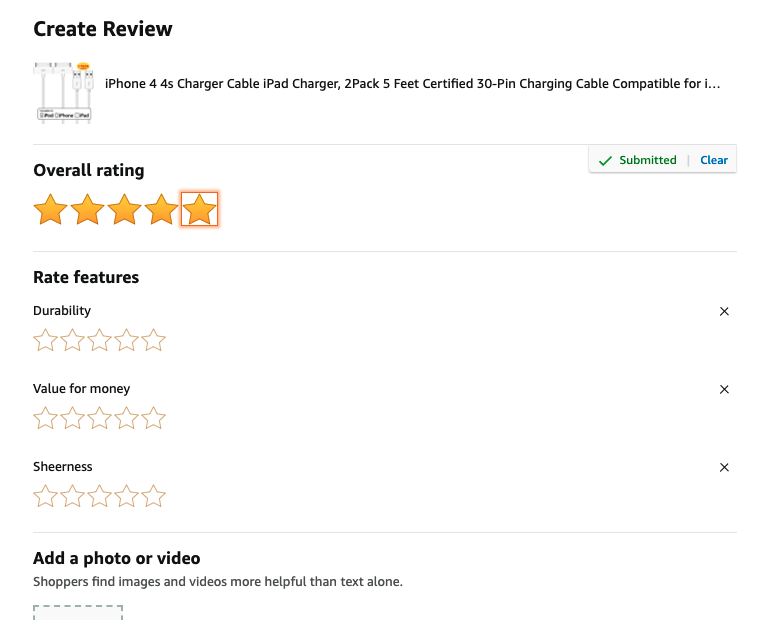
Also, the review prompts appear on various pages, for example, product detail page and homepage, to maximize their impression and increase review quantity.
Key takeaway:
- Use incentivized reviews to increase the number of reviews
- Make it easy for even your laziest customers to submit a review
- Make sure your review prompts show up on various touchpoints for customers’ convenience.
2. Recommend personalized products
30% of Amazon’s revenue comes from product recommendations.
The benefits Amazon gets from personalized recommendations are enormous. These include increasing conversion rates & average order value, site traffic & engagement rate, and customer satisfaction & loyalty.
It’s crazy to think about how successful Amazon is with its recommendation algorithm. Even now, the company is still vigorously testing new ways to do it better using their billions of data points.
So let’s take a peek into how they do it:
What is Amazon’s recommendation based on?
- Product’s popularity: Search keywords, reviews, return rates, etc
- Users’ behavior: browsing history, previous purchases, product browsing sections, etc
- Users’ demographics & preferences: age, income, location, etc
- Product attributes: its functionality, brands, specification, etc
- Others: content, price, stock level, delivery options, payment methods, etc
Amazon’s AI closely analyzes the relationship between users and products, products and products, as well as users and users. As a result, it can tell that a breastfeeding mother would often seek organic baby products, readers are more likely to be interested in books from the same author, or hot Tik Tokers heavily influence gen Z customers’ buying decisions.
Where to recommend products?
Amazon purposely shows product recommendations in nearly every step of the customer journey, from the homepage, category page, product page to even checkout and customer account pages.
Moreover, not restricting their chance to upsell and re-engage customers to their eCommerce website, they also send product recommendation emails.
In fact, according to Fortune.com, the email conversion rate is significantly higher than the on-site rate.
How do they recommend products?
Taking advantage of their massive data, Amazon has used many ways of recommendations to engage customers at various touchpoints:
Example 1: A full page of products from various categories that you’re interested in recently. As quoted from Amazon, this is “an easy way to navigate to pages you’re interested in after viewing product pages ”.
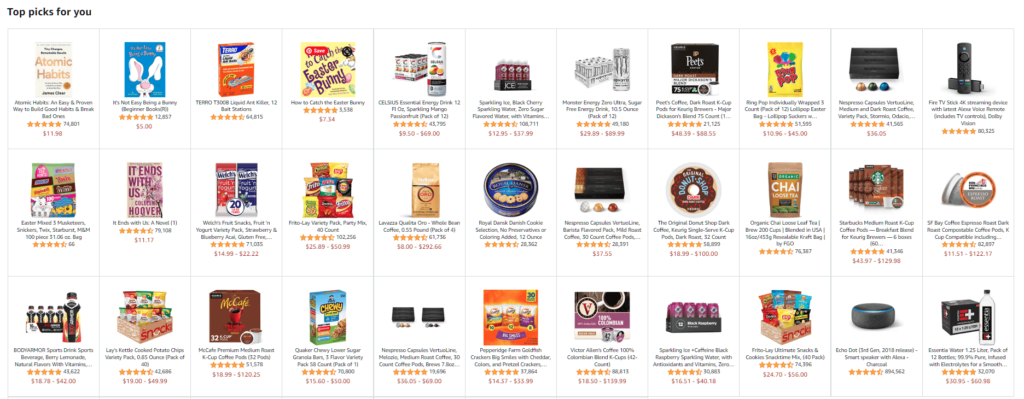
Example 2: The “Frequently bought together” to increase average order value (AOV)

Example 3: The “related products” is a mixed products bag of different prices, brands, colors, shapes, and sizes. The more variety of choices they offer, the more chance they can recommend the right product.

Example 4: comparing really similar items together to help users make decisions faster.
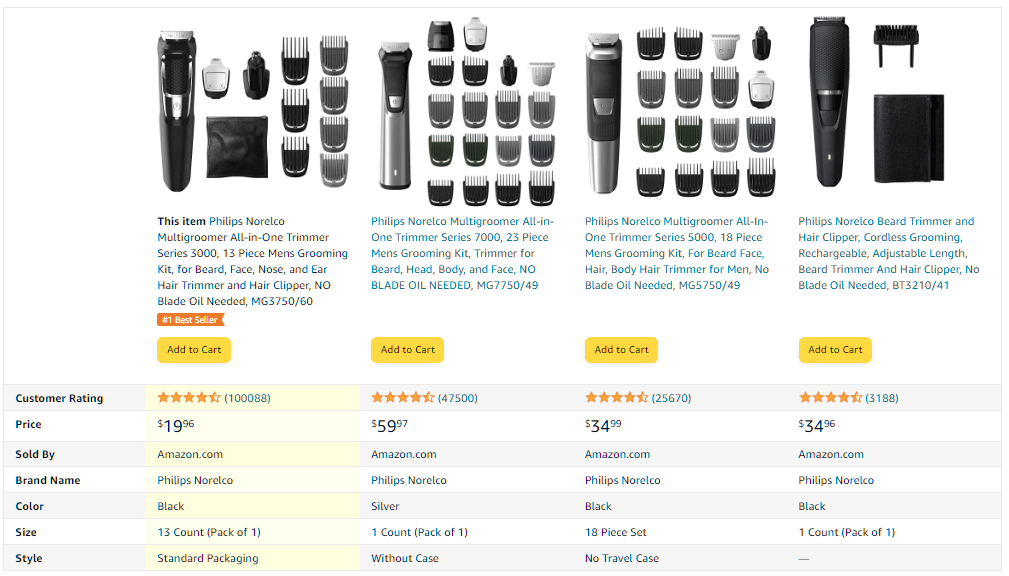
Example 5: Sending an email that recommends products based on what is in the cart.
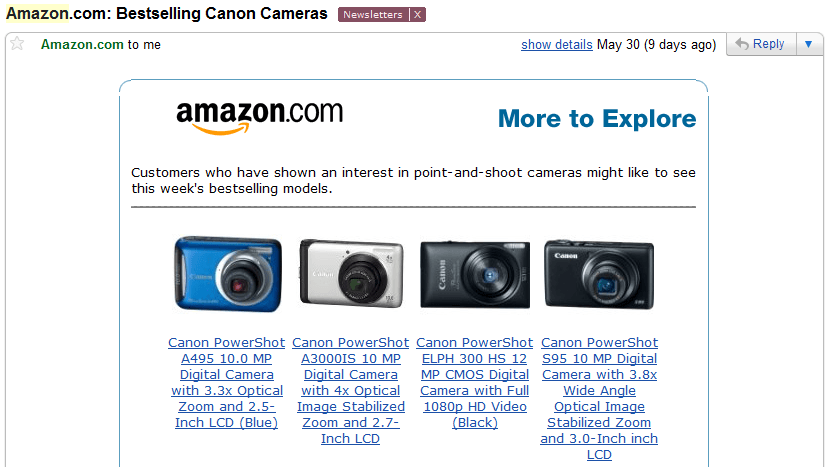
Example 6: product updates, because almost no one likes buying out-of-fashion stuff.

These are not everything. If you scan the whole Amazon website, you can find many other types of product recommendations and be amazed by how smart they are.
Takeaway:
- Use different sources of data as well as many channels to recommend products. There are a lot of tools for personalization nowadays to help you collect data & distribute messages effectively.
- Be creative when thinking of how to recommend products. There are many ways to address people’s needs besides a normal “related items” tab. Hopefully, you can invent one that Amazon has not thought of.
>> See more: eCommerce personalization
3. One-click ordering
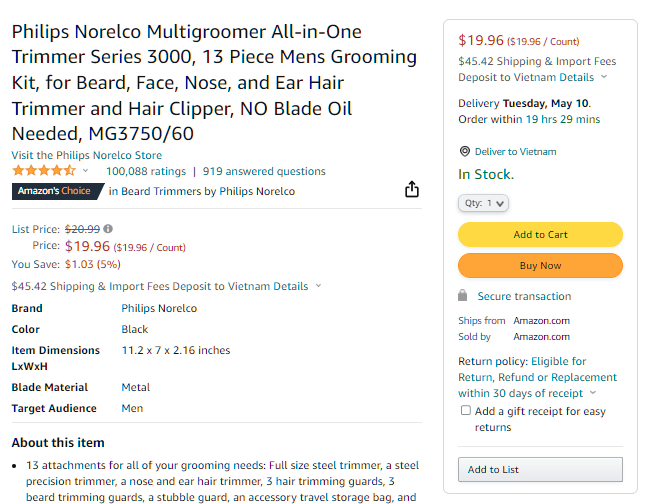
Back in 1999, when we were still renting movies and Nokia phone was a thing, Amazon bought a patent for its “one-click button”. For such a simple and intuitive system that was patented, the one-click technology raised lots of controversies then.
However, we know that Amazon, an already big company at that time, did not do anything without solid reasons.
Cutting unnecessary checkout steps greatly improves the customer buying experience and combats cart abandonment. 26% of people asked to exit eCommerce websites during checkout simply because they’re too impatient to follow that many steps.
Luckily, the patent expired in 2017, thus, many eCommerce companies can start using the one-click checkout as Amazon does.
How to master one-click checkout like Amazon?
Being a buzzy eCommerce innovation, the “buy now” button has some drawbacks. One of them is that it lets people purchase too quickly.
If customers make impulsive purchases and are unhappy about the product, they might think that your brands are evilly trying to take their money with the one-click CTAs.
So here is what Amazon does:
- Provide customers with everything they need to know before prompting them to buy with one click. Besides product price and attribute, they also include shipping fees, estimated delivery rate, secure payment information, and return policy. All information can be easily acquired right from the product page, without navigating to another lengthy policy site.
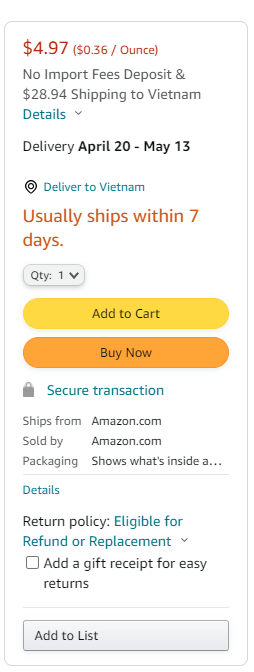
- Introduce a self-service customer support tool. After buying with one click, customers have 30 minutes to decide if they want to modify or cancel the orders. This smart move shows how Amazon is thinking for the sake of their customers, which inevitably increases trust.
Takeaway:
- Use one-click ordering to improve the checkout experience
- Provide customers with all necessary information such as return policy, shipping fees before prompting them to buy with one click
- Allow customers some time to cancel or modify orders after the orders are made to increase their satisfaction and build trust.
4. Data & Testing
From product recommendations to one-click orders, literally, every success Amazon has can be traced back to data analysis. The company is known to be a flag bearer in using Big Data to analyze customer behaviors. One of the most remarkable examples is the use of predictive analytics.
Predictive analytics is the application of data, algorithms, and machine learning in learning past data to foretell future events. Amazon has built a complex system to monitor customer behavior from many sources such as Alexa voice recordings and customers’ buying behaviors. The data is then used for every part of their business.
For example, Amazon can anticipate whether a user would want a product and when he is likely to buy. Then, they will allocate the product to the warehouse closest to that user, even before he or she has the buying intention.
“In retail, while things like the size of the catalog, advertising and other stuff might play a role in success, at Amazon, I think success is largely technology-driven”
– Werner Vogels, Chief Technology Officer, Amazon
Takeaway
For a starting eCommerce store, it’s unlikely to develop such a sophisticated analytic system as Amazon. The key point is to embrace data and analytics to improve sales and marketing strategies, as well as to smoothen business operations.
- Use tracking tools like Google Analytics, Hotjar, or an eCommerce personalization tool to monitor customer behaviors (with their consent),
- Use A/B testing to find out customers’ insight
5. Create a worthy loyalty program

Did you know that it costs 7 times more to acquire a new customer than to convert an old one? That’s why fostering customer relationships and getting frequent customers is the goal of every sustainable eCommerce business.
Guess who you can learn to retain customers from? Amazon. (of course)
They’ve got one of the best (if not best) engaging customer loyalty programs in the world.
And the one-star ingredient behind this success?
Instant gratification.
The eCommerce giant has long realized a problem with conventional loyalty programs: they offer no worthy value for customers.
Customers are told to do something like accumulating so many points (that’s worth a fortune) to get a 10% off, or buying ten boba teas to get one free. Lots of companies are using this tactic, and lots of customers are getting tired of it. It seems no longer attractive in this competitive world anymore.
Amazon, on the other hand, gives their customers a warm fuzzy feeling right away, without having to accumulate anything.
Example 1: Amazon Prime
Amazon Prime promises free shipping, same-day delivery, free music streaming, Prime video, personalized offers and Wholefood discounts. They smartly address our impatience and our natural liking for free stuff, exclusivity & entertainment. The offer is so attractive that people are willing to pay for it.
Amazon Prime’s number of users in the US has increased from 25 million in 2013 to 142.5 million in 2020, and is expected to reach 168.3 million in 2025.
Example 2: Amazon Smile
On a different page, Amazon Smile will donate 0.5% of purchase to the customer’s preferable charity foundation. This gives buyers a sense of meaning and makes them feel happier about each purchase.
Example 3: Amazon Contributor Awards
Another great example is Amazon Contributor Awards, which motivates buyers to leave helpful reviews. Top contributors whose content is the most useful and interesting are rewarded with personalized prizes.
Takeaway
Amazon has truly “gone to the infinity and beyond” to deliver the most customer-centric loyalty program. The secret sauce is no other than:
- Address customers’ initial needs rather than the company’s sales KPI
- Look for various ways to create pleasure besides heavy discounts. It can be many things: from ease and convenience, surprising personalized offers to helping them do a meaningful thing.
6. Do not ignore speed
Long before the booming age of eCommerce, Amazon has found out that “half a second delay will cause a 20% decrease in traffic” and “every 100ms delay in loading speed will cost 1% of their sales”.

Amazon’s Google Page Speed scores 70, which is not the highest result theoretically. However, you can easily tell by actual experience that their web pages load really fast, both on desktop and mobile. This is impressive considering that they have more than 12 million products and about 2 billion monthly traffic.
Takeaway:
It’s no wonder that Amazon’s engineers work hard to make the site load as fast as possible. Newbie eCommerce owners should not ignore speed, since it can be a vital factor in your overall digital experience.
Common practices to take:
- Choose a good hosting option or a fast SaaS eCommerce platform
- Reduce photo size
- Use advanced web technologies like AMP or PWA to improve the speed
Get a blazing-fast eCommerce website tomorrow (we literally mean tomorrow)
7. Return & refund policy is a must
When starting an eCommerce business, merchants often think about manufacturing, marketing, and pre-sales services, no one would think of a return & refund policy.
Although it’s an undesirable task to think about, eCommerce returns are quite normal, with the returning rates varying from 8% to 88% across industries.
When a return request happens, newbie merchants may be confused about how to handle it so that they neither upset their customers nor harm their growth.
Looking at how the big guy Amazon handles returns and refunds may give you a better idea:
Be informative and transparent
Amazon definitely has a lengthy returns and refunds policy, but it is crucial to inform customers of their rights while preventing further troubles for the company.
They straightforwardly address their customers’ top concerns: Can they return products? Within how many days can they request a return? Will they get a refund?
Moreover, as a huge marketplace, Amazon is well aware that not all products should be treated the same. Therefore, they are extremely careful to list out each specific condition for each product category.
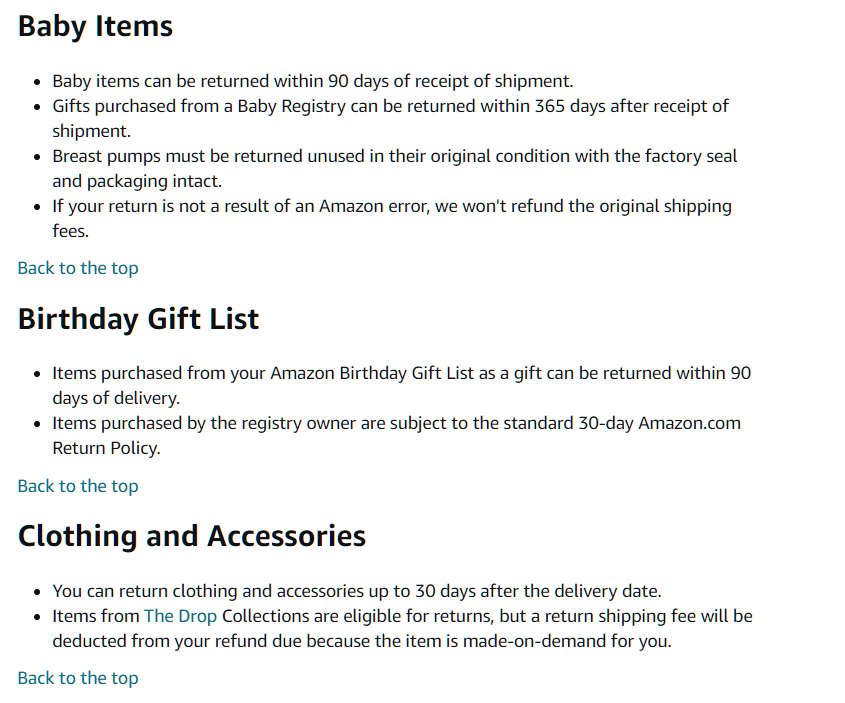
These information pages are sufficient for customers to grasp all necessary steps without having to call the help center.
Moreover, understanding that lots of customers would not bother reading a returns & refund policy before purchasing, Amazon transparently displays the info right on the product pages. The information is customized for each category, which accurately follows their written rules.

Customers’ convenience comes first
Besides traditionally shipping back items, customers can choose to directly return products to Amazon Hub Locker, nearby Kohl stores, or drop off items at UPS Access Point Locations.
Some return methods accept label-free and box-free, which means they do not need to print labels and package the item to return it.
Takeaway
- An informative and transparent return & refund policy pages
- Make sure the policy is easily accessible from selling pages.
- Make the process as simple and convenient for customers as possible.
>> See more: How to handle product returns?
8. Have a rich product page
Amazon is a competitive marketplace. In its ecosystem, there are nearly 2 million small and medium businesses growing. If you want to find a central hub to easily explore thousands of successful eCommerce sellers, Amazon is that place.
It’s easy to notice a common pattern among these sellers: they have a very rich product page. Their idea is simple: give customers everything they need to know so that they don’t have to find it anywhere else.
Lots of the content comes from delivery & return policy, personalized product recommendations, users’ reviews & FAQs that we have mentioned before.
However, it’s worth noticing that Amazon sellers also design specific product banners and give abundant product information to help customers decide if a product is right for them.
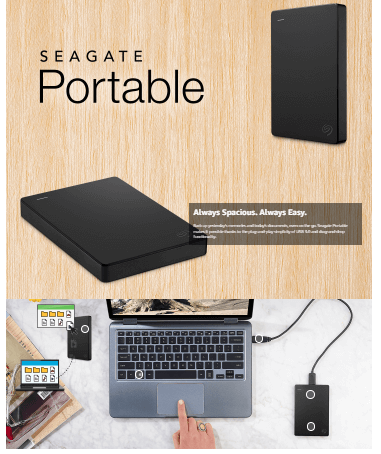
For example, a product page of Seagate’s external hard drive includes some fancy banners, super-detail technical specifications, warranty support, and even video generated by users.
Takeaway
- Provide as much useful product information on the product page as possible
- Use different mediums, from text to photos to videos
How can a new eCommerce site survive Amazon?
It’s difficult to start an eCommerce business, it’s even more difficult to start it with Amazon being so dominant. It’s like standing next to Angelina Jolie at a beach party and you have panda eyes and a muffin belly.
So, is it possible for a new eCommerce business to survive in this Amazon empire?
Yes, it is. Thousands of businesses are still making it. Also, you have privileges that Amazon sellers don’t. Amazon sellers must pay a CPA fee, comply with Amazon’s rules for incentivized reviews & return policy, as well as face many other restrictions.
On the other hand, individual eCommerce owners have the full freedom to build their brand awareness and find unconventional ways to reach and stay in touch with their customers.
Now, let’s dig deeper into the know-how:
Unique product
If customers could not find what you are offering on Amazon, they have no choice but to buy it from you.
This leads to another question: “Is there any product that Amazon doesn’t have?”.
Yes, there is. That’s why focusing on an eCommerce niche and creating in-depth products around that niche are very important.
Example: Package Free is an eco-conscious brand that sells products with minimum plastic ingredients and packaging.
They have some very unique products like disposable dental floss made from silk, or a reusable ear swab coming with a biodegradable case. These inventions easily make them a go-to destination for many eco-lovers.
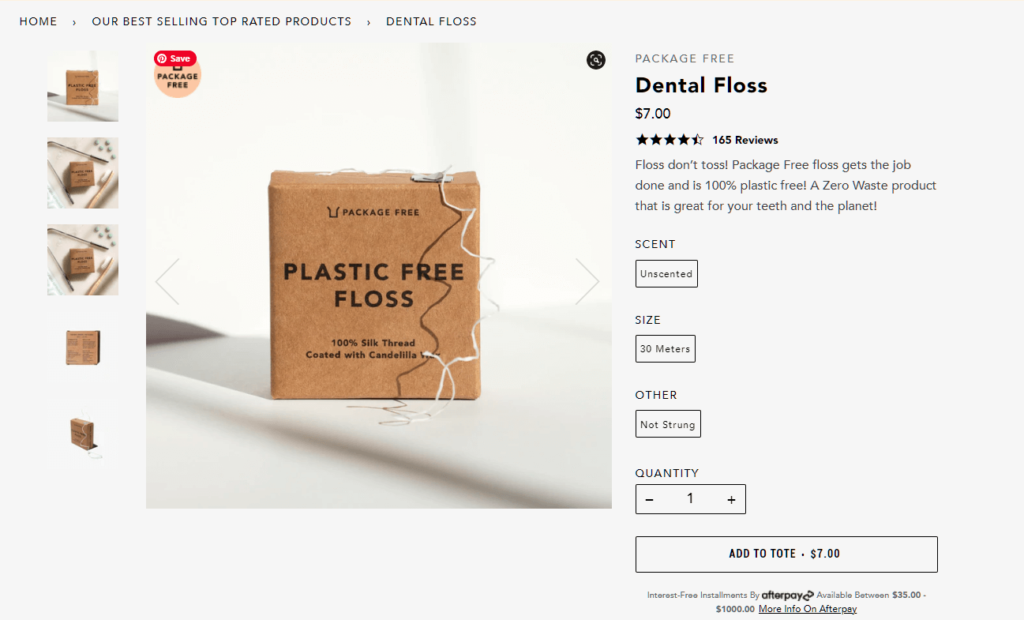
Focus on branding
In this age of mass consumerism, a customer buys from too many brands. If your brand does not stand out, he is very likely to forget you immediately.
Every memorable brand’s got a story and a mission that resonates well with their customer base. Also, they make sure that every step they make, every content & design they create stays in line with that mission. This helps them deliver a strong brand message that lasts long in people’s minds.
Example: Naja makes undergarments in various nude colors to match every skin tone. Its mission is to make the world, especially women’s world, a better place.

On their “about us” page, you can find that they employ single mothers and women in Colombia slums, pay above-the-average salaries, and donate 2% of their revenue to local charity organizations.
Moreover, if you take a look at their blog, you will find many inspirational articles that promote self-love and empower women.
Offline customer experience
Amazon is super popular in the online eCommerce market, but it’s not that powerful when it comes to brick-and-mortar stores. Amazon Go’s convenience store is a revolutionary idea, but the company has not expanded into other industries (e.g. electronics, fashions, etc) yet. Newbie merchants still have chances to provide an amazing offline customer experience to drive sales.
In fact, this is what independent bookstores did to survive Amazon Kindle.
Example: Independent booksellers in the US.
Try not to get eaten by Kindle, independent bookstores have made their offline buying experience more memorable.
Knowing that for certain book genres like children’s books, cookbooks, and fiction, customers often prefer to hold them in their hands before buying, they have changed their product selections to those.
Moreover, they found ways to attract customers, in this specific case, kids, to come to their brick-and-mortar stores. From parties to speakers, those kinds of events help them build greater relationships with young readers.

Furthermore, if you’re planning on opening a physical store along with an eCommerce store, brushing up on an omnichannel strategy is a great idea for growth. Omnichannel can smoothen the buying experience across on-and-offline, boost customer loyalty and help collect data more effectively.
Shake hands with Amazon
Amazon does not have to be the enemy, it can be a partner-in-crime helping you grow your business.
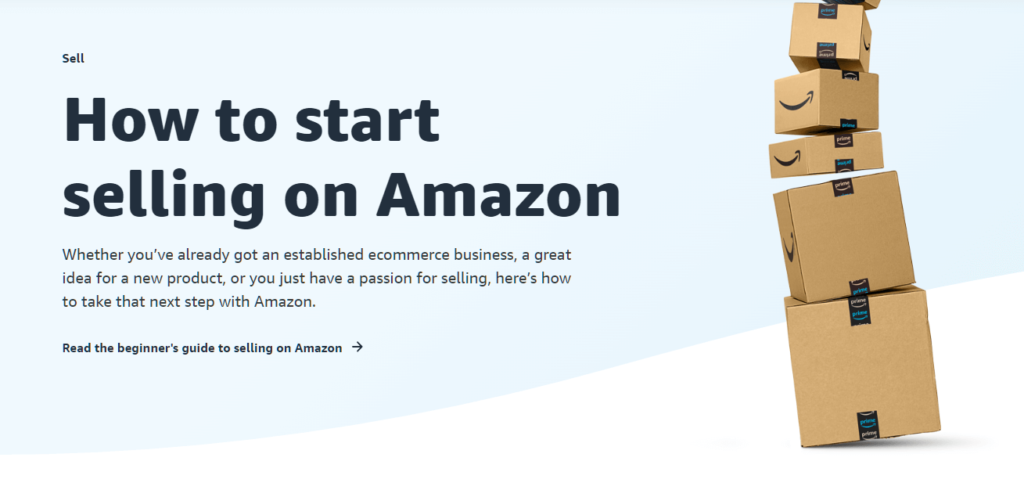
It’s a superb channel to reach new audiences and promote your unique products. You can also take advantage of its unparalleled shipping system to serve more customers, especially those living overseas.
The core of Amazon eCommerce strategy
Customer obsession, data-driven, and innovation focus are the best keywords to summarize Amazon eCommerce strategy. These also become crucial factors for a successful business in this modern age.
Starting a new business is tough nowadays, but by learning from the best, we hope that you can make remarkable achievements.





One key takeaway is the importance of building a brand presence and focusing on customer satisfaction. With Amazon’s vast customer base, it’s crucial to stand out and offer exceptional value.
The advice to leverage advertising and promotions wisely is spot on. A well-planned advertising campaign can boost visibility and sales.
Amazon is offering Amazon Promo Codes to encourage its users. If you apply the code you will get the discount.